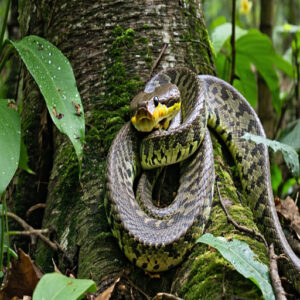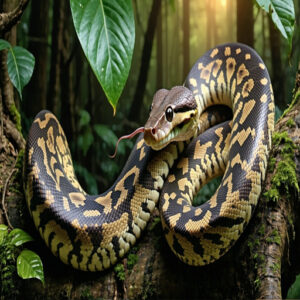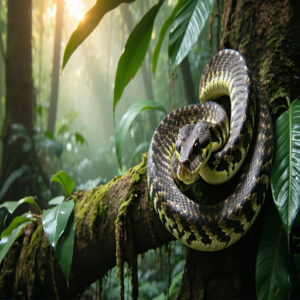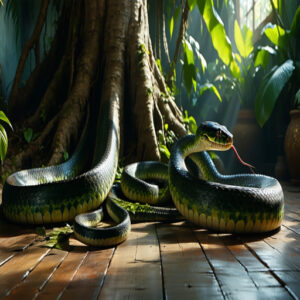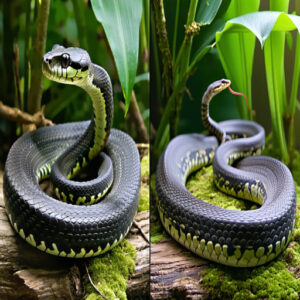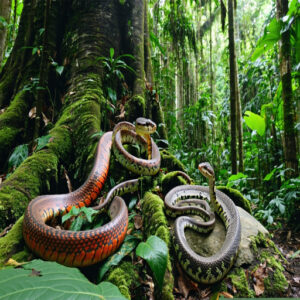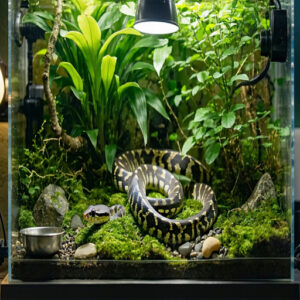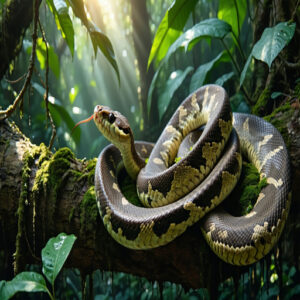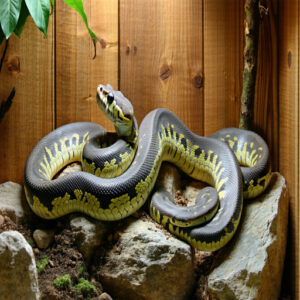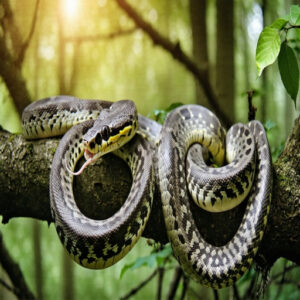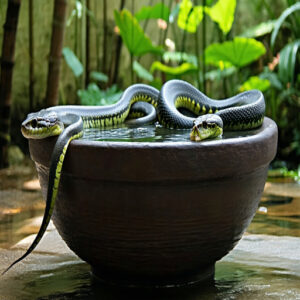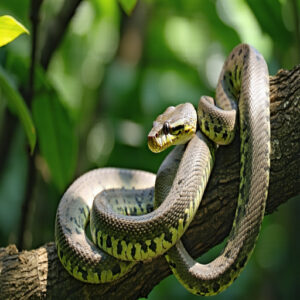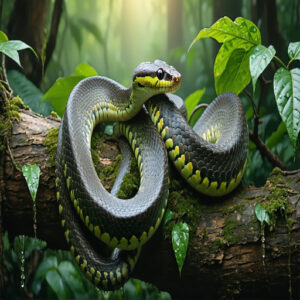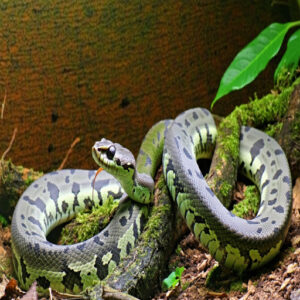This site is supported by our readers. We may earn a commission, at no cost to you, if you purchase through links.
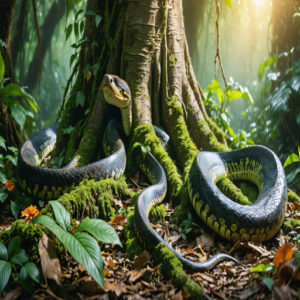
Some exceptional boas can even grow beyond 13 feet, and when they hatch, they’re only about 14 to 22 inches long but grow fast—doubling their size in the first year and hitting 4 to 6 feet by year two.
Their growth slows after three years but doesn’t completely stop, and their size depends a lot on genetics, diet, and environment.
Want to learn about specific boa types, like dwarf boas or red-tailed giants, keep reading!
Table Of Contents
- Key Takeaways
- Boa Constrictor Growth Patterns
- How Big Do Boa Constrictors Get
- Boa Constrictor Size Comparison
- Factors Impacting Boa Constrictor Size
- Enclosure Sizing for Boa Constrictors
- Nutrition and Boa Constrictor Growth
- Water Bowl Sizing and Humidity
- Lifespan and Size of Boa Constrictors
- Health and Size Relationship
- Caring for Your Boa Constrictor
- Frequently Asked Questions (FAQs)
- How big do Baby boa constrictors get?
- How big do boa constrictor snakes get?
- How long do boa constrictors live?
- How big does a boa constrictor imperator get?
- How fast do boa constrictors grow?
- Are boa constrictors bigger than male Boas?
- How big is a full grown boa constrictor?
- What is the largest boa constrictor ever found?
- Do boas get bigger than pythons?
- Are boa constrictors good pets?
- Conclusion
Key Takeaways
- Female boa constrictors typically grow larger than males, reaching 6.5 to 10 feet and sometimes exceeding 13 feet, while males average 5 to 8 feet.
- Boa constrictor growth depends on genetics, diet, and environment, with females growing faster during their first three years and after sexual maturity.
- Dwarf boas, shaped by island ecology, stay much smaller, usually under 6.5 feet, making them a unique choice for smaller spaces.
- Boa constrictors grow their whole lives, but their growth slows after year three, emphasizing the need for proper nutrition and spacious enclosures.
Boa Constrictor Growth Patterns
Boa constrictors grow quickly during their first three years, thanks to factors like diet, temperature, and genetics.
After reaching sexual maturity, their growth slows but continues throughout their lives, with females typically getting much larger than males, influenced by genetics.
Factors Affecting Growth Rate
Boa constrictor growth is like a puzzle, and several pieces fit together to shape their size.
Genetic influence sets the foundation, but environmental factors like temperature and humidity can make or break it.
Here’s how growth works:
- Nutrient intake: High-quality prey helps boas thrive.
- Hormone levels: These regulate metabolic rate and impact growth patterns.
- Stress: Poor handling or cramped enclosures slow development.
- Habitat: Spacious environments encourage natural growth to their full potential.
It’s all about balance!
Average Weight and Length
You’ve probably noticed snake size variations can be wild, and boas are no exception.
The average boa constrictor size impresses—females typically weigh 60-100 pounds and stretch between 6.5-10 feet long, while males are smaller.
These muscular beauties have:
- Thick bodies like a wrestler’s arm
- Heads tennis ball-sized, for grabbing prey
- Scales with gleaming armor-like patterns
- A mid-body girth rivaling a dinner plate
Their boa constrictor length and weight truly make them nature’s heavyweight champs!
Growth Timeline
Understanding the growth stages of a boa constrictor is key to their care.
Hatchlings start at 14-22 inches, doubling in size by year one (3-4 feet).
By year two, they’re 4-6 feet, with sexual maturity kicking in.
Growth slows after year three (6-8 feet), but gradual size increases continue beyond year four, reaching their maturation process and potential max size.
How Big Do Boa Constrictors Get
Boa constrictors can grow to impressive sizes, with females often reaching 8-10 feet and males slightly smaller at 6-8 feet.
Some, like the red-tailed boa, can exceed 10 feet, while island boas usually stay under 6.5 feet due to limited food, which affects the overall size of the boa constrictors.
Red-Tailed Boa Size
The Red-Tailed Boa, known for its striking coloration, can grow impressively large.
Adult females often outsize males, reaching lengths of 6.5-10 feet, sometimes exceeding these numbers.
With muscular builds weighing 60-100 pounds, they’re truly remarkable.
Male red-tailed boas, though smaller, aren’t far behind in size.
Snake growth depends on size factors like diet and environment, making each red boa unique in its development.
Island Form Boa Size
If you’re tight on space but want a boa, island boas might be the perfect fit.
These small species, shaped by boa genetics, top out at under 6.5 feet thanks to tropical habitats with limited prey.
Despite their smaller boa constrictor size, they’re fierce hunters, like their mainland relatives.
- Adapted to dense vegetation for easier movement
- Smaller size matched to available food
- Excellent hunting skills rival larger snake morphs
Maximum Recorded Length
The maximum recorded length for a boa constrictor is jaw-dropping—over 13 feet!
That’s taller than some one-story buildings.
These snakes are native to tropical South America.
While most stay smaller, this record demonstrates their incredible growth potential when conditions are perfect.
Curious about size comparisons?
Check out this boa constrictor size chart:
| Type | Average Length | Maximum Length |
|---|---|---|
| Typical Boas | 6.5–10 feet | 13+ feet |
| Red-Tailed Boas | 7–10 feet | 12+ feet |
| Dwarf Boas | 20–30 inches | 2.5 feet |
Even though giant boas like this are rare, it’s a cool glimpse into the limits of snake length!
Boa Constrictor Size Comparison
Male and female boa constrictors can grow to very different sizes, with females often being much larger.
Their size also depends on the subspecies, with some boas staying small, like dwarf boas, while others grow much longer and heavier.
Male Vs Female Size
Regarding boa constrictors, females are the bulkier, bigger stars of the show.
Female boas often hit 6-7 feet in three years, while their male counterparts stall at 4-6 feet.
Why? Nature gave them this edge for reproduction.
| Feature | Female Size | Male Size |
|---|---|---|
| Avg. Length (Adult) | 7-10 feet | 5-7 feet |
| Weight Range | 60-100 pounds | 15-23 pounds |
| Growth Rate | Faster | Slower |
| Purpose of Size | Carry offspring | Compete/mate |
That’s the fascinating size variance between male and female boas!
Subspecies Size Variations
Size genetics and habitat shape boa constrictor subspecies.
The Boa constrictor constrictor often outgrows the Boa constrictor imperator, especially in lush rainforests where prey is abundant.
The Hog Island Boa’s size is influenced by insular dwarfism factors.
| Subspecies | Average Length | Maximum Length | Habitat Type | Notable Feature |
|---|---|---|---|---|
| Boa c. constrictor | 10-13 feet | 13 feet | Rainforests | Vibrant red tail |
| Boa c. imperator | 6-8 feet | 10 feet | Forests/Savannas | Smaller size |
| Island Form Boa | 5-6 feet | 6.5 feet | Islands | Insular dwarfism |
| Red-Tailed Boa | 6.5-9 feet | 10 feet | South America | Reddish tail |
| Hog Island Boa | 5-6 feet | 6.5 feet | Islands (Honduras) | Pale coloration |
Females typically grow larger, reflecting male-female size differences.
Dwarf Boa Size
In the context of compact snake species, dwarf boas are a standout.
Their adult size is an impressive 3-4 feet, perfect for smaller habitats.
These boas, shaped by limited island resources, pack impressive traits into a small frame.
| Feature | Dwarf Boa | Standard Boa |
|---|---|---|
| Adult Length | 3-4 feet | 6-13 feet |
| Weight Limit | ~4-6 lbs | Up to 60-100 lbs |
| Hatchling Size | ~10 inches | 14-22 inches |
| Habitat Space Needed | Tiny tanks | Large enclosures |
| Typical Prey | Lizards | Birds and mammals |
They’re proof big personalities can fit in tiny packages and are a great example of how dwarf boas can thrive in smaller environments, making them a unique choice for those interested in compact snake species.
Factors Impacting Boa Constrictor Size
Boa constrictor size isn’t random—it depends on things like temperature, diet, and their genetic makeup.
If you want your boa to grow healthy and strong, you’ll need to understand how these factors work together, especially genetic makeup.
Temperature and Growth Rate
Temperature control is like setting the stage for your boa constrictor’s growth spurts.
Keeping the heat between 80-92°F helps crank up their metabolism, speeding up how they process food into size gains.
Warmer spots in this range can turn on a growth boost, while cooler temperatures might slow things down.
Thermal regulation is key—too cold, and their development stalls.
The environmental impact is huge, so set consistent heat cycles to help your snake reach its average length or even its max size.
Proper enclosure size guidelines are also essential for supporting the boa’s overall health and growth.
Diet and Prey Availability
What your boa eats can make or break its growth.
Prey selection and feeding habits play a massive role in boa constrictor size and weight.
Wild boas thrive on variety, while in captivity, you’ve gotta provide a balanced boa constrictor diet for steady growth.
Focus on nutrient intake and stick to these feeding guidelines:
- Offer prey matching 1-1.5x your boa’s mid-body girth.
- Smaller, frequent meals encourage faster boa constrictor growth.
- Food quality matters—choose healthy, fresh prey.
- Keep feeding habits consistent for predictable boa constrictor weight and size.
A steady meal plan equals a happy, growing snake!
Hormonal Changes and Growth
Your snake’s growth isn’t random; hormones drive the process.
Growth hormones push rapid early length increases, while hormone regulation balances things out before puberty.
Once sexual maturity hits, testosterone and estrogen spikes slow things down.
By adulthood, minimal growth happens.
| Phase | Hormonal Impact | Effect on Development |
|---|---|---|
| Juvenile | Growth Hormones Surge | Fast growth, length increases |
| Pre-puberty | Regulated Hormones | Steady boa constrictor growth |
| Sexual Maturity | Testosterone & Estrogen | Growth rate slows substantially |
| Adult | Stabilized Hormone Levels | Growth almost stops |
Enclosure Sizing for Boa Constrictors
You’ve got to make sure your boa constrictor’s enclosure matches its size, or it won’t have enough room to move around comfortably.
Juveniles need smaller spaces, like 4 ft by 2 ft enclosures, but adults will require much larger habitats, often at least 8 ft long.
Juvenile Enclosure Requirements
When setting up your baby boa constrictor’s first home, remember this: they need space to stretch and grow.
A 4-foot-long, 2-foot-wide, and 24-inch-high enclosure works well for healthy boa constrictor growth.
Focus on enclosure design that mimics their natural snake habitat.
Proper boa enclosure materials are essential for creating a suitable environment.
Here’s the must-have checklist:
- Heating options: Maintain 80-92°F with under-tank heaters or lamps.
- Humidity control: Keep it around 60-70% with misting or a water bowl.
- Substrate selection: Use aspen bedding or coconut fiber for burrowing.
- Boa enclosure security: Strong, ventilated lid to prevent escapes.
With these basics, your snake’s early years will be smooth!
Adult Enclosure Requirements
Once your boa constrictor outgrows its juvenile setup, it’s time for a larger enclosure that matches its adult size.
Aim for at least 8 ft x 4 ft x 4 ft—a perfect fit for their natural movements.
Good space allocation prevents stress, and strong ventilation systems keep the air fresh.
Maintain temperature control between 80-92°F and humidity levels at 60-70%.
Add climbing branches and sturdy hides for activity and security.
Don’t underestimate their strength—secure doors tightly!
Look for flexible lighting options to mimic day-night cycles.
When designing the enclosure, consider large snake enclosures to guarantee a safe and healthy environment for your boa constrictor.
| Feature | Size/Requirement |
|---|---|
| Enclosure Size | 8 ft x 4 ft x 4 ft |
| Temperature Range | 80-92°F |
| Humidity Levels | 60-70% |
| Floor Space | 10 square feet minimum |
| Security | Lockable doors, solid latches |
Enclosure Size Based on Snake’s Projected Adult Size
Thinking ahead to your boa’s projected adult size means less hassle later.
A boa constrictor enclosure should match their eventual max size to keep them comfy and healthy.
Here’s what’s key:
- Females average 6-8 feet, males 4-6 feet; build for this range.
- Use minimum dimensions of 8 ft x 3 ft x 3 ft for adults.
- Add 20% extra space for hiding spots and climbing branches.
- Snakes in tight enclosures risk stress, poor shedding, or limited movement—plan enough reptile room size!
Proper boa constrictor enclosure size is vital for maintaining the health and well-being of your pet boa.
Nutrition and Boa Constrictor Growth
What you feed your boa constrictor has a big impact on how fast it grows and how healthy it stays.
By giving the right prey size and sticking to an age-appropriate feeding schedule, you can help your snake reach its full potential safely.
Importance of Proper Nutrition
Feeding your boa right isn’t just about tossing in a snack and calling it good.
Nutrient balance plays a big role in its size, growth rate, and overall health.
High-quality food guarantees strong muscles, smooth skin, and proper energy.
Plus, good feeding strategies help prevent issues like digestive problems or stunted growth.
Some owners explore dietary supplements for captive boas, but sticking to well-fed, appropriately sized prey keeps things simple.
Remember, nutrition truly shapes your boa constrictor’s max size.
Prey Size and Growth Rate
Choosing the right prey isn’t just a detail—it’s one of the biggest growth factors for your boa.
Prey selection should match your snake’s needs, typically 1-1.5 times its body’s widest point, keeping digestion smooth and nutrient-packed.
Feeding habits like using smaller prey facilitate quicker digestion, making snake nutrition more effective.
Oversized meals? They can slow boa constrictor growth rate, strain digestion, and hinder reaching the boa constrictor max size or the average length of boa constrictors, which is a critical aspect of boa constrictor care.
Feeding Frequency and Growth
Meal frequency is one of the biggest factors in snake development and growth rates.
A consistent feeding schedule helps your boa constrictor grow properly without health problems or stress.
Here’s how you can tailor feeding schedules to your snake’s age and size:
- Baby boas need meals every 7 days to support their rapid growth and hit their average length of 6-8 feet by 3 years.
- Adults eat every 10-14 days, keeping a steady pace toward their boa constrictor max size.
- Stick to prey no wider than your snake’s body, as oversized prey risks choking or regurgitation, slowing boa constrictor growth.
Stay consistent for best results!
Water Bowl Sizing and Humidity
Your boa needs a water bowl that’s big enough for soaking but not so deep that it becomes unsafe.
Keeping the right bowl size also helps maintain proper humidity levels, which is essential for their health and comfortable shedding.
Importance of Adequate Water Bowl Size
Keeping your boa’s water bowl the right size isn’t just a checklist item—it’s key to your snake’s comfort and hydration.
A shallow, stable bowl cuts tipping risks while ensuring easy access for drinking or even soaking, especially for larger boas.
Think of their bowl as a multipurpose spa: hydration, relaxation, and temperature stability all in one.
Proper water bowl maintenance is essential for preventing bacterial growth and ensuring your snake’s overall health.
Match bowl size with their length, keeping water quality fresh and bowl depth appropriate.
A solid bowl supports growth milestones perfectly!
Here’s a quick boa size guide:
| Boa Size | Bowl Width | Depth | Material |
|---|---|---|---|
| Hatchling (2 ft) | 8 inches | 3 inches | Ceramic |
| Adult (10 ft+) | 24+ inches | 6-8 inches | Weighted rim |
Water Bowl Size and Humidity
A well-sized water bowl isn’t just for snake hydration—it helps regulate humidity levels inside your boa’s enclosure.
By choosing the right size, you create a balance that supports your snake’s growth and health.
- Aim for bowls with a wide surface area (12-15 inches) to boost evaporation and humidity.
- Stick to heavy ceramic or sturdy plastic to avoid tipping during soaking.
- Keep water clean, at room temperature, and away from heat to control water quality and reduce rapid loss.
Lifespan and Size of Boa Constrictors
Boa constrictors can live 20 to 30 years in captivity, so you’ll be caring for them for a long time.
Their size, ranging from 6 to 13 feet, often affects their lifespan, with proper care being key to keeping them healthy.
Average Lifespan in Captivity
You can expect a boa constrictor in captivity to stick around for 20 to 30 years.
That’s a serious commitment, but with the right care, their life expectancy is impressive.
Factors like diet, low stress, and proper habitat influence their survival rates and overall health.
The connection between their size and lifespan is fascinating—healthy boas slowly grow their whole lives, reaching impressive sizes like 8–13 feet long or even 100 pounds.
To maximize captive longevity, make sure their needs are met daily.
Happy boas live longer, thrive, and keep mortality risks low.
Maximum Lifespan Recorded
The boa constrictor’s longevity is impressive, especially the largest boa constrictor maximum lifespan recorded: 40 years, 3 months, and 14 days.
That’s longer than many beloved pets. Most, though, won’t reach such an age.
Want your boa to thrive? Focus on these:
- Longevity Factors: Genetics and healthcare.
- Proper diet.
- Ideal enclosure setup.
- Controlled temperatures.
- Regular vet check-ups.
Relationship Between Size and Lifespan
The link between boa constrictor size and lifespan is undeniable, with larger boas often living longer.
Here’s how size factors into their lifespan:
- Bigger boas, like females, tend to outlive smaller counterparts, reaching 25-30 years.
- Balanced growth guarantees health and longevity.
- Genetics set limits on both lifespan and the largest boa constrictor’s potential size.
- Environmental care, like proper feeding, sharpens their growth limits and age impact.
The concepts of size, growth, genetics, and environmental care all play a role in determining the lifespan of a boa constrictor, highlighting the importance of Bigger boas and Balanced growth in achieving longevity.
Health and Size Relationship
A boa constrictor’s health has a big impact on how large it can grow, so keeping it healthy is super important.
Problems like poor nutrition or stress can slow growth and even lead to serious health issues.
Impact of Health on Size
Your boa constrictor’s health sets its growth path.
Parasites, stress, and nutrient deficiencies are major growth inhibitors, stunting the average boa constrictor length and weight.
Regular check-ups prevent disease effects, ensuring your snake hits its size limits.
A healthy diet fuels growth, not obesity, and regular check-ups are crucial for maintaining health, and keep temperatures right, manage humidity, and watch for warning signs—these essentials keep the boa constrictor growth rate steady and strong.
Preventing Health Issues
Keeping your boa healthy is key to proper growth and avoiding issues like stunted size.
Focus on disease prevention and a stress-free habitat to promote their well-being. Regularly reviewing snake health issues can help you identify potential problems early on.
- Health Monitoring: Schedule quarterly vet check-ups and monitor for parasites through fecal exams.
- Feeding Strategies: Avoid overfeeding to prevent snake obesity and maintain steady boa constrictor growth.
- Clean Environment: Deep clean the enclosure weekly, spot-check daily, and manage humidity for ideal boa constrictor care.
Caring for Your Boa Constrictor
Taking care of a boa constrictor means giving it the right-sized enclosure, proper humidity, and plenty of space to grow.
You’ll also need to focus on nutrition, regular feeding, and keeping an eye on its health to guarantee it thrives, which involves considering proper humidity as part of its overall care.
Providing a Suitable Environment
To keep your boa comfy and healthy, focus on space requirements.
An adult’s enclosure should be at least 8 ft x 4 ft x 4 ft.
Keep a temperature gradient—80°F on one side, 92°F on the other.
Add hiding spots (think logs or caves) and use a substrate that holds moisture for proper humidity levels.
Good ventilation and fitting the setup to your snake enclosure size guarantee a thriving snake!
Nutrition and Feeding Recommendations
A proper meal plan keeps boas healthy and growing.
Offer prey that’s about the same width as your boa every 10-14 days—rats and mice work great.
Boost nutrient balance by gut-loading prey 24 hours before feeding with healthy foods.
Use frozen prey stored properly, thawed fully in warm water.
Smart feeding strategies guarantee steady growth, ideal boa constrictor size, and long-term well-being.
When selecting frozen foods, consider the benefits of frozen rat prey for a balanced diet.
Regular Health Check-Ups
Regular vet visits are like check-ups for your boa; they’re key to tracking boa constrictor growth rate and spotting issues early.
Schedule bi-annual visits for health monitoring, including parasite control and medical tests.
A vet guarantees your feeding plan supports proper boa constrictor size, hygiene, and growth, keeping them on track for the average boa constrictor length, while preventing stunted growth or health problems like infections or scale rot.
Frequently Asked Questions (FAQs)
How big do Baby boa constrictors get?
Baby boas burst into the world measuring 14-22 inches long and weighing about 2 ounces.
By seven months, they can stretch to 3 feet and weigh 30 pounds, depending on their meals and care.
How big do boa constrictor snakes get?
Adult female boa constrictors reach 6-10 feet, sometimes more, while males average 5-8 feet.
The biggest can hit 13 feet, but size depends on food, genetics, and habitat.
Females are always the larger ones.
How long do boa constrictors live?
These snakes can live 20-30 years in captivity if you take care of them right.
Proper food, a comfy enclosure, and consistent temperature play a huge role in their lifespan—kind of like houseplants, but cooler!
How big does a boa constrictor imperator get?
Imagine seeing a six-foot-long snake in your room—well, boa constrictor imperators often grow to 5-7 feet for males and 6-8 feet for females.
They’re strong, sleek, and thrive with proper care.
How fast do boa constrictors grow?
They grow quickly in their first three years, hitting 6-8 feet and around 60 pounds by then.
After sexual maturity, growth slows, but diet and care still nudge them toward their lifelong growing trend.
Are boa constrictors bigger than male Boas?
Female boa constrictors usually outsize the males, growing up to 13 feet compared to males maxing out around 8 feet.
They’re bulkier too, often weighing more, which is handy for survival and reproduction.
How big is a full grown boa constrictor?
A full-grown constrictor can stretch up to 10 feet, sometimes more, with females often larger than males.
These thick-bodied snakes pack serious muscle, weighing over 100 pounds, depending on diet, habitat, and genetics!
What is the largest boa constrictor ever found?
The largest boa constrictor ever recorded reached a length of 18 feet, though it was later identified as a green anaconda.
For boa constrictors alone, the record is 13 feet—an impressively massive and rare specimen!
Do boas get bigger than pythons?
Think of boas as the muscle cars of snakes—impressive but not the biggest.
Pythons, especially reticulated ones, outgrow them, reaching lengths of over 20 feet, while boas typically max out around 13 feet.
Are boa constrictors good pets?
They’re fascinating pets if you’re prepared.
Boa constrictors need roomy enclosures, regular feeding, and careful handling to stay healthy.
They grow big, live decades, and develop unique personalities, but they’re not for everyone—definitely a long-term commitment!
Conclusion
So, size, speed, and surprises make boa constrictor growth fascinating, don’t they?
Whether they’re hitting 10 feet or staying smaller as dwarf boas, their growth relies on genetics, diet, and care.
Knowing how big boa constrictors get helps you plan the right enclosure, provide proper nutrition, and support their health.
With females often outgrowing males, and some subspecies reaching record lengths, there’s a lot to learn.
Ready to give your boa the best environment possible?

